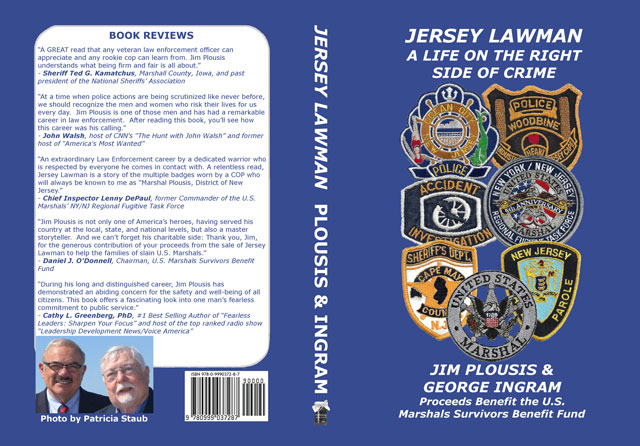Story by Jim Plousis
More than a decade ago, an important anniversary was approaching.
On September 19, 2009, the U.S. Marshals Service would celebrate the 220th anniversary of its founding. Each district was encouraged to generate special events to focus public attention on the history of a great law enforcement organization.
As the U.S. marshal for New Jersey, I envisioned an event that would recall those thrilling days of yesteryear when intrepid marshals brought law and order to the West.
My problem was that, to most people, the Garden State is better known for tomatoes, blueberries, the Sopranos, and corrupt politicians than cowpokes and quick-on-the-draw marshals.
But in South Jersey’s rural Salem County we have CowTown Rodeo, which bills itself as the “oldest weekly rodeo in the United States.” Every Saturday evening from May to late September this venue offers bull riding, steer wrestling, tie-down roping, bare back riding, and other traditional events.
The man running CowTown is Grant Harris, whose great-grandfather started the first rodeo there. So I called the local sheriff and asked him to arrange a meeting with Harris to discuss hosting a rodeo event marking the historic anniversary. “I just want to give you a heads up,” Sheriff Chuck Miller confided before we met the rodeo kingpin. “When you shake hands with Grant, he’s missing a finger on his right hand. He’s a real cowboy, and he lost his thumb in a roping accident that took it clear off at the joint.”
A real cowboy, indeed. At age 8, Grant Harris was a Junior Bullriding Champion. He was a professional rodeo competitor at age 14, and later went to Casper College in Casper, Wyoming, on a full rodeo scholarship.
Soon I was face-to-face with a mountain of a man, someone just a little shorter than John Wayne, who spiked his conversation with aphorisms like, “That guy has a big hat but no cattle.” Grant invited us to lunch at a local down-home bar. On his recommendation we ordered a prime rib sandwich an inch thick, including gristle.
Munching on food that would horrify a cardiologist, I explained my idea for a rodeo ceremony to highlight our anniversary. Grant listened thoughtfully.
When I finished, he said: “I’ll have a rodeo for you. But there’s one thing I want. If we’re doing this for the Marshals Service, we have to have marshals riding in the opening ceremony.”
“OK,” I said. “I’ll get some marshals.” I called Arlington, Virginia, knowing that our director had grown up on a farm and rode horses. He declined. No one else there was interested as well.
Grant Harris was not pleased when he heard the news. “Then I’m just not gonna do it,” he told me. “It makes no sense to have a ceremony for the Marshals Service with no marshals in it.”
After a pause he said, “What about you?”
“Grant, I haven’t been on a horse in 30 years.”
“I’ll teach you.”
I called U.S. Marshal Dave Thomas in neighboring Delaware. “Get ready,” I said. “It’s you and me. We’re taking riding lessons because you’re the only other marshal I could get.”
Our first session with Grant was like a first day in Kindergarten.
“Here’s how you put the blanket on the horse,” he explained. “Here’s how you put the saddle on…This is how you strap the saddle…You put the bit in the horse’s mouth this way…”
Then we mounted up and rode in circles, learning how to stop and start. After six hours of instruction, Grant said it was enough for one day.
As we started to dismount, Dave, who was wearing combat boots, got his foot stuck in a stirrup. He tumbled to the ground, smacking his head. Grant could not conceal his disdain. “What are you guys, jackasses?!” he yelled. “You gotta have cowboy boots to ride a horse! You can’t wear things like that!”
After our third lesson, which included Sheriff Miller, Grant told us we had done so well that he would let us herd some cattle. Our assignment was to move 40 head from a pasture across the road from CowTown to an adjacent field.
It was a blazing hot day and we were in the saddle until 4 o’clock in the afternoon. My backside was as sore as a baby with an unchanged diaper.
The night of the big rodeo finally arrived. Dave Thomas, Sheriff Miller, and I waited on horseback in the chutes. With some 3,000 spectators looking on, the rodeo contestants and the three of us were supposed to parade into the arena carrying the Marshals Service flag and other flags.
But Dave had trouble controlling his horse. “Get that horse straight!” Grant barked. He finally got the critter positioned, and the event began.
The crowd cheered when we were introduced and trotted out into the arena like Glenn Campbell’s rhinestone cowboys, except that we were attired in our uniforms. The script called for us to line up, salute the American flag and in unison with the audience, recite the Pledge of Allegiance and sing the National Anthem. (Back in those days, no one took a knee.)
In addition to the pomp and circumstance, we had a colorful display of Marshals Service paraphernalia, including body armor, shields, and stick-on badges. Winners of the various events also received belt buckles embossed with the Marshals Service emblem.
I’ll bet a glass of sarsaparilla at your neighborhood saloon that the event that year garnered more attention than any other anniversary celebration for the Marshals Service.
Jim Plousis is a former U.S. marshal. This article is adapted from “Jersey Lawman,” a memoir of his 40 years in law enforcement. Proceeds from the book go to the U.S. Marshals Survivors Benefit Fund.









